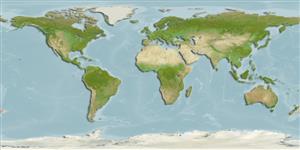Classification / Names
ชื่อสามัญ | ชื่อพ้อง | Catalog of Fishes(สกุล, ชนิด) | ITIS | CoL | WoRMS | Cloffa
subclassHolocephali (chimaeras) (chimaeras) >
Chimaeriformes (Chimaeras) >
Chimaeridae (Shortnose chimaeras or ratfishes)
Etymology: Chimaera: Named for the mythological creature composed of parts of multiple animals, referring to their odd mix of characteristics. (See ETYFish); carophila: Named for Carol and Phil Kemper (caro + phil), supporters of chimaeroid research (and the senior author’s parents). (See ETYFish).
Environment: milieu / climate zone / depth range / distribution range
นิเวศวิทยา
เกี่ยวกับทะเล,น้ำเค็ม สัตว์หน้าดินในเขตน้ำลึก; ระดับความลึก 846 - 1350 m (Ref. 107024), usually ? - 1000 m (Ref. 107024). Deep-water; 32°S - 49°S, 166°E - 171°W (Ref. 107024)
Southwest Pacific: deep water slopes and plateaus surrounding New Zealand (Challenger Plateau, Chatham Slope and Rise, Hikurangi Trench, Campbell Plateau,
Bounty Plateau).
ขนาด / น้ำหนัก / Age
Maturity: Lm ? range ? - ? cm
Max length : 104 cm TL เพศผู้/กระเทย; (Ref. 107024); 97.5 cm TL (female); น้ำหนักสูงสุดที่มีการรายงาน: 4.8 kg (Ref. 122636)
Short description
สัณฐานวิทยา | ความยาวต่างๆ
This species is distinguished by the following characters: a short, blunt snout and an anal fin separate from the ventral caudal margin by a notch; medium-bodied with a gently rounded snout; large eye; oral and preopercular lateral line canals usually share a short common branch off of the infraorbital canal; relatively short first dorsal fin and spine; second dorsal fin even along height, long caudal dorsal and ventral margins, short, trifurcate pelvic claspers, divided distally for approximately one-third of their length; body colour uniform pale-brown, mouth and ventral snout darker with brownish-purple fins and highly deciduous skin. Distinguished from its closest congeners, Chimaera fulva, C. macrospina, and C. obscura, by a combination of morphological characters (longer caudal dorsal margin, shorter pelvic claspers, shorter dorsal fin spine, shorter first dorsal fin, and longer caudal ventral margin) and coloration (Ref. 107024).
The depth range of occurrence of this species seems to follow the 1000 m depth contour around New Zealand, but may be an artifact of sampling. Size range for juvenile females 27.7-75.9 cm TL (18.2-37.6 body length) and males 41.0-83.5 cm TL (16.7-52.2 cm BDL); for adult females 85.5-103.5 cm TL (51.9-59.9 cm BDL) and males 74.0-97.5 cm TL (48.7-57.0 cm BDL) (Ref. 107024).
Life cycle and mating behavior
วัยเจริญพันธุ์ | การสืบพันธุ์ | การวางไข่ | เซลสืบพันธ์ของเพศเมีย(ไข่) | ความดกของไข่ | ตัวอ่อน
Kemper, J.M., D.A. Ebert, G.J.P. Naylor and D.A. Didier, 2015. Chimaera carophila (Chondrichthyes: Chimaeriformes: Chimaeridae), a new species of chimaera from New Zealand. Bull Mar Sci. 91(1):63-81. (Ref. 107024)
IUCN Red List Status (Ref. 130435)
Threat to humans
Harmless
Human uses
ข้อมูลเพิ่มเติม
ชื่อสามัญชื่อพ้องกลไกการเผาผลาญพลังงานผู้ล่าการศึกษาเกี่ยวกับผลกระทบของสารประกอบทางเคมีที่เป็นอันตรายต่อสิ่งมีชีวิต ประชากร และสิ่งแวดล้อมการสืบพันธุ์วัยเจริญพันธุ์การวางไข่การรวมกลุ่มวางไข่ความดกของไข่เซลสืบพันธ์ของเพศเมีย(ไข่)Egg development
อ้างอิงการเพาะเลี้ยงสัตว์น้ำประวัติการเพาะเลี้ยงสัตว์น้ำสายพันธุ์พันธุศาสตร์ElectrophoresesอัตราพันธุกรรมโรคการแปรรูปNutrientsMass conversion
ผู้ร่วมมือรูปภาพหลายรูปStamps, Coins Misc.เสียงปลามีพิษ เช่น ปลาปักเป้าความเร็วรูปแบบการว่ายน้ำพื้นที่เหงือกOtolithsสมองวิสัยทัศน์
เครื่องมือ
Special reports
Download XML
แหล่งที่มาจากอินเตอร์เน็ต
Estimates based on models
Phylogenetic diversity index (Ref.
82804): PD
50 = 0.5000 [Uniqueness, from 0.5 = low to 2.0 = high].
Bayesian length-weight: a=0.01000 (0.00244 - 0.04107), b=3.04 (2.81 - 3.27), in cm total length, based on all LWR estimates for this body shape (Ref.
93245).
ระดับชั้นอาหาร (Ref.
69278): 3.7 ±0.6 se; based on size and trophs of closest relatives
ความสามารถในการกลับคืนสู่ปกติ (Ref.
120179): ต่ำ, เวลาต่ำสุดที่จะทำให้ประชากรเพิ่มขึ้นเป็น 2 เท่าใช้เวลา 4.5 - 14 ปี (Preliminary K or Fecundity.).
Fishing Vulnerability (Ref.
59153): High vulnerability (62 of 100).
